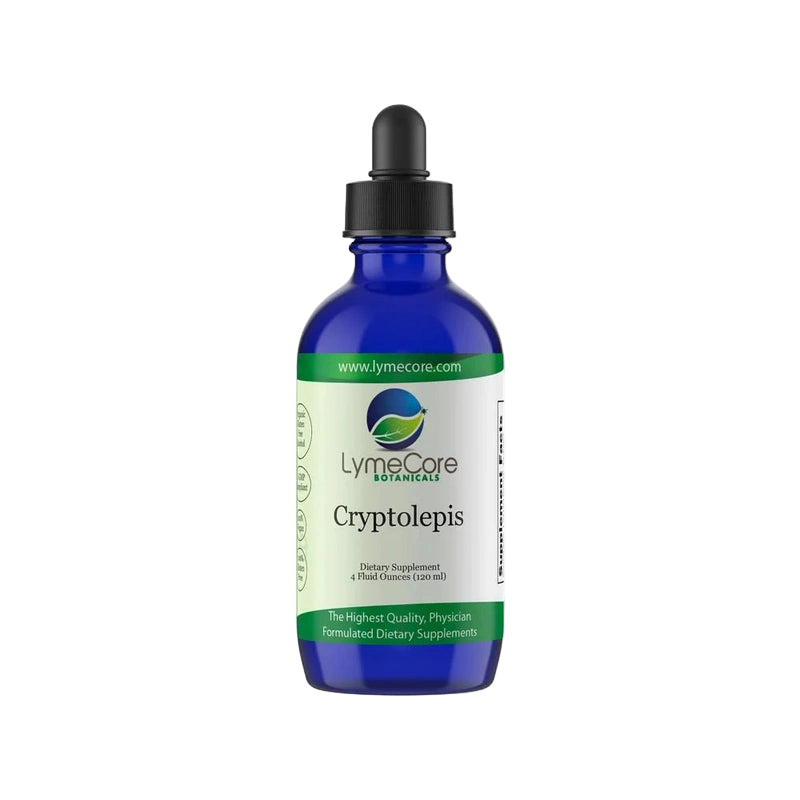Cryptolepis
Cryptolepis
Couldn't load pickup availability
Our extracts are made using premium lab tested organic or wildcrafted herbs. They are created using precise measurements, monitoring, and testing per GMP standards. *
Purity and Potency Guaranteed! We use the highest quality raw materials available.

Cryptolepis sanguinolenta, also known as Cryptolepis or Ghanaian quinine, is a plant native to West Africa. Cryptolepis has a long history of traditional use including for the treatment of various infectious diseases including malaria. This plant contains a variety of bioactive compounds, including alkaloids such as cryptolepine and quindoline, which have shown promising antimicrobial properties. Studies have indicated that Cryptolepis extracts may exhibit inhibitory effects against Borrelia burgdorferi, the bacterium responsible for Lyme disease, as well as other tick-borne pathogens. Moreover, the plant’s constituents have displayed anti-inflammatory and immunomodulatory activities, which could be beneficial in reducing the severity of Lyme disease symptoms and supporting the body’s immune response against tick-borne infections.
Persister cells are a small subpopulation of bacteria that can enter a dormant state and become highly resistant to antibiotics. They are believed to play a role in the persistence of Lyme disease symptoms and the challenges of eradicating the infection completely. While there is limited specific research on the effects of Cryptolepis on persister cells in Lyme disease, some studies have suggested that Cryptolepis extracts may exhibit antimicrobial activity against Borrelia burgdorferi, the bacterium that causes Lyme disease, including the persister forms. These studies have reported that Cryptolepis extracts may be able to inhibit the growth or viability of Borrelia burgdorferi persister cells in vitro (in a laboratory setting).
Properties:
- Antimicrobial Activity: Cryptolepis has been found to contain alkaloids, such as cryptolepine, which exhibit antimicrobial properties. While the direct impact on tick-borne bacteria is not well-established, these antimicrobial properties suggest potential benefits in combating infections associated with tick-borne diseases.
- Antiparasitic Effects: Tick-borne diseases can involve not only bacteria but also parasites, such as Babesia and Bartonella. Cryptolepis has been traditionally used in Africa for its antiparasitic properties, which may be relevant in addressing these co-infections.
- Anti-Inflammatory Properties: Cryptolepis has shown anti-inflammatory effects in certain studies. In tick-borne diseases, inflammation can contribute to tissue damage and symptoms. By reducing inflammation, Cryptolepis may help alleviate some of these effects.
In recent years, there has been some interest in its potential role in treating Lyme disease, including its ability to target persister cells.
Research:
Borrelia
- “Antibacterial and Antiplasmodial Activities of Extracts from Cryptolepis sanguinolenta” (2008): This study investigated the antibacterial and anti-malarial properties of Cryptolepis sanguinolenta extracts. While it did not focus specifically on tick-borne diseases, it demonstrated the broad-spectrum antimicrobial activity of the plant, suggesting its potential effectiveness against various pathogens.
- “Antibacterial and Antiprotozoal Activities of Cryptolepis sanguinolenta and Its Active Constituents” (2014): This study examined the antibacterial and antiprotozoal activities of Cryptolepis sanguinolenta and its active constituents. While it did not focus specifically on tick-borne diseases, it found that the plant extracts and isolated compounds exhibited significant antimicrobial effects against various bacteria and parasites.
- “In Vitro Antibacterial Activity of Cryptolepis sanguinolenta and Cleistopholis patens Against Borrelia burgdorferi” (2015): This study investigated the antibacterial activity of Cryptolepis sanguinolenta and Cleistopholis patens extracts against Borrelia burgdorferi, the bacteria responsible for Lyme disease. The researchers found that the extracts demonstrated inhibitory effects on the bacteria, suggesting their potential as natural antibacterial agents against Lyme disease.
Babesia
- “In vitro evaluation of antiprotozoal activities of cryptolepine, quindoline, and related analogues” by Nduka Okafor et al. (2001): This study evaluated the antiprotozoal activity of cryptolepine, a major alkaloid derived from Cryptolepis sanguinolenta, against various protozoan parasites, including Babesia microti. The study found that cryptolepine demonstrated activity against Babesia microti in vitro.
- “Antibabesial and antimalarial activities of OZ78 compared to current registered drugs” by Dirk D. Wege et al. (2016): This study compared the activity of OZ78, a synthetic analogue of cryptolepine, against Babesia divergens, Babesia microti, and Plasmodium falciparum (the malaria parasite). The results showed that OZ78 exhibited potent activity against both Babesia parasites.
Bartonella
- “In vitro antimicrobial activity of cryptolepine, a major alkaloid isolated from Cryptolepis sanguinolenta” by C. Wright et al. (2010): This study examined the antimicrobial activity of cryptolepine, the major alkaloid found in Cryptolepis sanguinolenta, against various bacteria, including some Gram-negative bacteria. While Bartonella species were not specifically studied, the results showed significant antimicrobial activity against several bacterial strains.
- “Antimicrobial activity of Cryptolepis sanguinolenta alkaloids from cell cultures” by B. Marcourt et al. (2014): This study investigated the antimicrobial activity of Cryptolepis sanguinolenta alkaloids, including cryptolepine, against various bacteria. Although Bartonella was not a specific focus, the study showed moderate to strong activity against several bacterial strains
* These statements have not been evaluated by the FDA. These products are not intended to diagnose, treat, cure or prevent any disease.
Share




